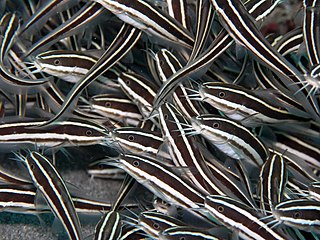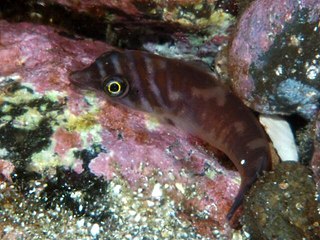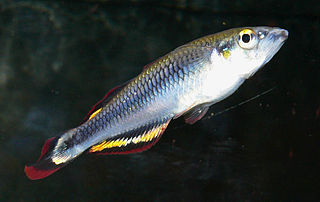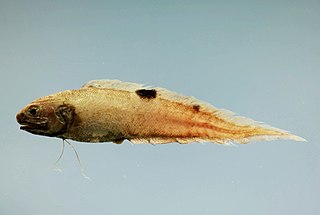Ophidiiformes is an order of ray-finned fish that includes the cusk-eels, pearlfishes, viviparous brotulas, and others. Members of this order have small heads and long slender bodies. They have either smooth scales or no scales, a long dorsal fin and an anal fin that typically runs into the caudal fin. They mostly come from the tropics and subtropics, and live in both freshwater and marine habitats, including abyssal depths. They have adopted a range of feeding methods and lifestyles, including parasitism. The majority are egg-laying, but some are viviparous.

Callichthyidae is a family of catfishes, called armored catfishes due to the two rows of bony plates along the lengths of their bodies. It contains some of the most popular freshwater aquarium fish, such as many species in the genus Corydoras.

The eeltail catfish are a family (Plotosidae) of catfish whose tails are elongated in an eel-like fashion. These catfishes are native to the Indian Ocean and western Pacific from Japan to Australia and Fiji. The family includes about 41 species in 10 genera. About half of the species are freshwater, occurring in Australia and New Guinea.

Eleotridae is a family of fish commonly known as sleeper gobies, with about 34 genera and 180 species. Most species are found in the tropical Indo-Pacific region, but there are also species in subtropical and temperate regions, warmer parts of the Americas and near the Atlantic coast in Africa. While many eleotrids pass through a planktonic stage in the sea and some spend their entire lives in the sea; as adults, the majority live in freshwater streams and brackish water. One of its genera, Caecieleotris, is troglobitic. They are especially important as predators in the freshwater stream ecosystems on oceanic islands such as New Zealand and Hawaii that otherwise lack the predatory fish families typical of nearby continents, such as catfish. Anatomically, they are similar to the gobies (Gobiidae), though unlike the majority of gobies, they do not have a pelvic sucker.

The eel-tailed catfish is a species of catfish of the family Plotosidae. This fish is also known as dewfish, freshwater catfish, jewfish, and tandan.
Gymnotus is a genus of Neotropical freshwater fish in the family Gymnotidae found widely in South America, Central America and southern Mexico. The greatest species richness is found in the Amazon basin. They are sometimes referred to by the English name banded knifefish, although this typically is reserved for the most widespread species, G. carapo. Overall Gymnotus is the most widespread genus in the order Gymnotiformes.

The Pimelodidae, commonly known as the long-whiskered catfishes, are a family of catfishes.

Clingfishes are ray-finned fishes of the family Gobiesocidae, the only family in the suborder Gobiesocoidei of the order Blenniiformes. These fairly small to very small fishes are widespread in tropical and temperate regions, mostly near the coast, but a few species live in deeper seas or fresh water. Most species shelter in shallow reefs or seagrass beds, clinging to rocks, algae and seagrass leaves with their sucking disc, a structure on their chest.

Wallago is a genus of catfishes order Siluriformes of the family Siluridae, or sheatfish. They are found in rivers throughout southern and southeastern Asia. The only extant species of this genus is Wallago attu.

Aspidoras is a genus of catfishes of the family Callichthyidae from Brazil.
Neoplecostominae is a subfamily of South American catfishes of the family Loricariidae. Species of this subfamily live in high-mountain and swift-flowing river habitats.

Bedotia is a genus of the family Bedotiidae of fishes endemic to Madagascar.
Gogo is a small genus of catfishes of the family Anchariidae. It includes four species.
The freshwater cobbler is a species of catfish of the family Plotosidae. The freshwater cobbler originates from coastal drainages of southwestern Australia, from the Frankland River to the Moore River. The species may reach about 50 centimetres (20 in) total length.

Cavefish or cave fish is a generic term for fresh and brackish water fish adapted to life in caves and other underground habitats. Related terms are subterranean fish, troglomorphic fish, troglobitic fish, stygobitic fish, phreatic fish, and hypogean fish.

Histiophryne is a genus of marine ray-finned fishes belonging to the subfamily Histiophryninae in the family Antennariidae, the frogfishes. These fishes are found in waters ranging from Taiwan to South Australia. There are currently five known species. These fishes are easily distinguished from other anglerfishes as having a reduced luring appendage, a highly evolved form of the first dorsal fin spine.

Nudiantennarius is a monospecific genus of marine ray-finned fish belonging to the family Antennariidae, the frogfishes. The only species in the genus is Nudiantennarius subteres, the deepwater frogfish. This fish is found in the Western Pacific Ocean.
Tandanus tropicanus or the wet tropics tandan is a species of eeltail catfish native to Australia. It was discovered in rivers between Townsville and Cairns by a group of scientists from James Cook University. The species, which grows to length of about 20 inches (51 cm), has a cylindrical body tapering to a thin, eel-like tail. It has small eyes and a large mouth surrounded with barbels.

Neobythitinae is a subfamily of cusk eel from the family Ophidiidae. They are mostly fishes of deeper waters, occurring from the continental shelf down to as deep as 8,370 metres (27,460 ft) at the bottom of the Puerto Rico Trench where the deepest known fish, Abyssobrotula galatheae, has been taken.













